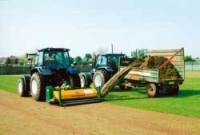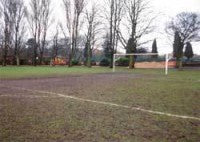The Campey route to quality pitches
The Campey route to quality pitches
By Sue Meeken

It is tempting to try to overcome the budget situation by introducing less frequent maintenance schedules, with extended intervals between regular key tasks like grass cutting and turf aeration. But this can be a false economy, since it can encourage undesirable, disease-prone, weak and thatch-forming grasses like poa annua, and aggravate the waterlogging problem. Regular turf management and renovation cannot be sacrificed, even when money is tight.
Many local authorities are overcoming this Catch 22 situation by using cost-effective Koro equipment from Campey Turf Care Systems. Campey are UK and Eire distributors for this line-up of specialist machines developed by Ko Rodenburg, the Parks Superintendent of Rotterdam City Council, who is responsible for nearly 300 sports pitches. These innovative machines dramatically improve waterlogged surfaces without major costs. They also improve the physical composition of the soil and enhance turf vigour without undue reliance on chemicals and other man-made treatments.
Indeed, the Koro and Campey Turf Care Systems approach is very much to stress a mechanical not a chemical maintenance regime, using simple and environmentally friendly means to manage sports surfaces or renovate if necessary. Recognising there is little that can be done about temperature or light levels, they provide a means to control surface water and air circulation around the grass swards to give them the best chance to thrive.
Pressure to take this approach is increasing. Initially it was in Europe that the use of amenity and sports turf chemicals was banned or severely restricted, but now laws and regulations have been drafted here to control where and how chemicals can be sprayed on to turf. On local authority playing fields, fertilizers are literally applied at the public's feet ! Greater precautions are now taken to protect the public, other creatures and plants as well as the water course from harmful chemicals, but being able to avoid their use would seem preferable.
Typical of the KORO machines designed to improve pitch condition, in partricular, drainage and removal of the dreaded Poa Annua, are the Field Topmaker, Recycling Top Dresser and Top Drainer, either used alone or together, depending on the variety of problems being tackled.

For quick turf rejuvenation, the tractor-mounted Koro Field Topmaker has blades that can be set from 4cm above ground to 6cm below, to skim off the top layer of soil. At a high setting, the Field Topmaker will fraise mow the ground to remove irregularities and restore a level surface ready for
overseeding. Set lower, the standard blades remove thatch, organic material and shallow rooting grasses, leaving the roots of the desired species like perennial ryegrass roots intact for re-growth. The Field Topmaker can be fitted with deep vertical scarifying blades which will carry out linear aeration up to 2". Simultaneously, the material is removed on to the hydraulically driven conveyors into a trailer alongside. By cutting through and removing much of the thatch water, air and nutrient permeation is encouraged, and because vertical blades sever lateral growth, conditions for a healthier and more active sward are provided.
Often used following the Koro Field Topmaker, the tractor-driven Koro Recycling Dresser achieves three operations in one, namely aeration, decompaction and top-dressing. The machine has two sets of blades, the digging blades break up compacted soil to depths of up to 20cm and then coulter blades are pulled through cracking and fissuring the soil profile to improve surface drainage. The soil which has been removed during this process is then re-distributed back onto the playing surface as top dressing.
Not only does the Recycling Dresser combat problems such as thatch, but it also creates ideal overseeding conditions and by 'recycling' existing soil, less material has to be imported to site, which gives significant cost savings and removes any risk of contamination from dressings or new top-soil purchased from outside. In addition, no cores or other debris are left on the surface, minimising the amount of heavy equipment that has to travel over the turf. If feasible, the Recycling Dresser can be used four or five times a year, during the growing season, to obtain maximum mixing effect, and keeping interruption of play to a minimum.

Once waterlogging problems have been overcome, it is of course essential to keep them that way. This can be achieved by regular use of another machine in the Campey portfolio, the Striegel Spring Tine Grass Harrow. Available in 3, 4.5 and 6m widths, the unit consists of 1.5m grass combs with 5mm-diameter tines that follow ground contours closely. The Harrow opens up the sward and removes thatch and lateral growth to promote healthy grass without reliance on pesticides and herbicides.
The use of verti-cutting harrows as frequently as 20 times per year is common among greenkeepers and groundsmen in Continental Europe. The Striegel units are unique in that they have been developed specifically for sports turf and golf course maintenance.

Similarly, for areas or intense wear that are a great risk of waterlogging, such as soccer goalmouths, Campeys offer the Koro Culti-Roll. This relieves compaction without affecting surface levels. The 1.5m-wide machine has a double row of winged compaction legs that till the soil down to a maximum depth of 15cm (6in) and leave the ground ready for seeding.
Richard Campey, Managing Director of Campey Turf Care Systems, says that an increasing number of local authorities are reaping the benefits of Koro equipment, empowered by the 'Best Value' approach to service procurement. This allows council departments to make choices according to optimum overall cost-effectiveness, rather than the former CCT (Compulsory Competitive Tendering), which dictated that choices be made on grounds of cheapness alone.
Adopting Campey's mechanical approach to turf maintenance will reap significant results on a sensible budget, but it is important that turf managers use such specialist equipment regularly as a preventative measure, rather than as an emergency treatment when pitches are in trouble. A planned programme of mowing, deep aeration and harrowing will set local authorities on the Campey route to quality, and could set the sports stars of tomorrow on the road to glory.
